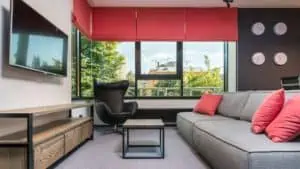Sometimes you have a window that sits in direct sunlight and needs a big, heavy curtain to prevent your furniture from taking the brunt of the rays. Other times, you have a window that doesn’t get a ton of light. Maybe you live in a relatively cloudy area, or maybe you have a window that isn’t facing the sun. Either way, you’ll need a window treatment that is optimized for low light areas.
1. Honeycomb Shades
Honeycomb shades, also known as cellular shades, are a popular kind of shade at the moment. They’re known for energy efficiency, which basically means that they prevent too much air from moving between the window and the house. Yep, honeycomb shades can improve the insulation of your house. But also, the special design of the honeycomb is built to trap and refract more light than a basic shade. This means that low light areas will glow more than usual, but you’ll still have your privacy with the shade. It’s a great choice.
2. Wooden Vertical Blinds
Vertical blinds, also known as venetian blinds, are popular on windows that go all the way down to the floor (like a sliding glass door). While the white plastic is a bit tacky for the modern house, a sleek wooden design can really bring out the light of low light areas. If you use a lighter wood, you can make the room a bit brighter. If the wood is darker, you’ll close off more of the light. The wood will hold up really well if you put it in low light areas, out of direct sunlight. Also, where wood can allow light to bounce through direct sunlight, you’ll avoid that if you use wood in lower light areas.
3. Sheer Curtains
Darker curtains won’t work well in low light areas. You’ll block the little bit of natural light that you could have gotten. But you also don’t want to leave the window simply open, because that won’t give you much privacy. Sheer curtains, curtains that have a little bit of transparency to them, can give you plenty of privacy while still allowing light through into the room.
4. Low-light Plants
If you have a more natural, bohemian, Brooklyn look in your space–you might not want to put up curtains or shades at all. Hanging plants can give you a lot more privacy while allowing you to block a little bit of the light. Ivy is a great choice, and many types of ivy don’t actually need direct sunlight. Alternatively, you can throw shelves across your window and then put up plants on that shelf.
5. Solar Shades
Solar shades are a kind of shade that is built specifically with a bit of transparency. They can allow light into the room, and can even provide enough visible light to keep plants healthy. Solar shades can be used in low light areas to create a brighter room while still giving you privacy.
6. Sheer Ripple Fold Drapes
If you haven’t heard of ripple fold drapes, they are a kind of drape that has an exaggerated curl. While most drapes have enough fabric to gently cover the window, a ripple fold drape has a lot of extra fabric so that it bunches up, creating a rippling effect. Instead of being pulled taut over the window–it is loosely draped over the whole thing.
While traditional ripple fold drapes will block a lot of light, which might not be optimal for a low light area, you can get sheer ripple fold drapes that will allow some light to illuminate the room. If you’re concerned with privacy, the ripple fold design will give you a bunch of privacy!
7. Valance
If you still want the natural light to come through the window but are mostly concerned with decorations so that it doesn’t look so bare, a valance is a great option. A valance is a strip of fabric that covers the top of the window without restricting the rest of it. It allows for a lot of light to come through, and no privacy. Often, valances are paired with blinds to allow for more function.
8. Silk Curtains
Silk is a sheen, gleaming material that reflects a lot of light. If you put up silk curtains in front of a lower light window, the silk will reflect a lot of the light outward. But if you part the curtains a little bit, they will be illuminated by the low light and will scatter it around the room. Silk curtains definitely don’t fit every design scheme, but they’re a great statement piece when they do.
9. Light Roman Shades
Roman shades are a single piece of fabric that bunches when you pull it up. While a traditional roman shade may not be ideal for a low light scenario, a more sheer Roman shade will give you a covering for the window that doesn’t restrict too much of the natural light.
10. Woven Wooden Shades
Shades don’t have to be made out of fabric. Shades can also be made out of a woven wood that can roll up, just like a fabric shade. While wooden shades can block a lot more light than a sheer fabric, they can also allow more natural light to breathe through the cracks in the woven wood. For low light settings, they can create a great ambience.
11. Pleated Shades
Pleated shades are similar to the cellular, honeycomb shades, but are more layered. Pleated shades block more of the light than cellular shades, and will provide a bit more privacy. Pleated shades usually come in lighter, more basic colors. In low light situations, these basic colors can start to look a bit gray and dull. Getting a sand or brown color can bring out softer, warmer colors in the room.





